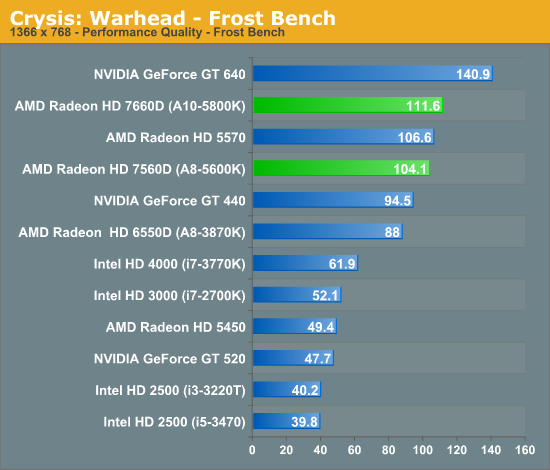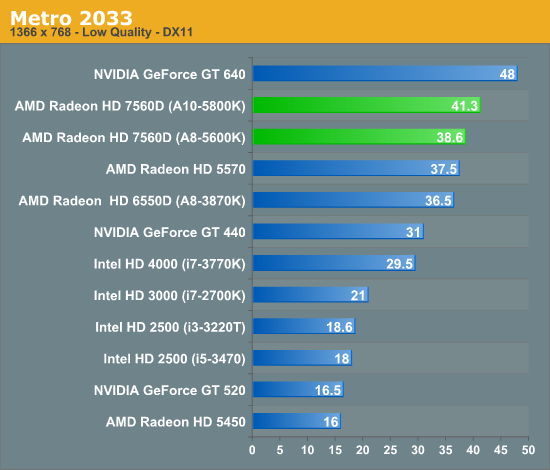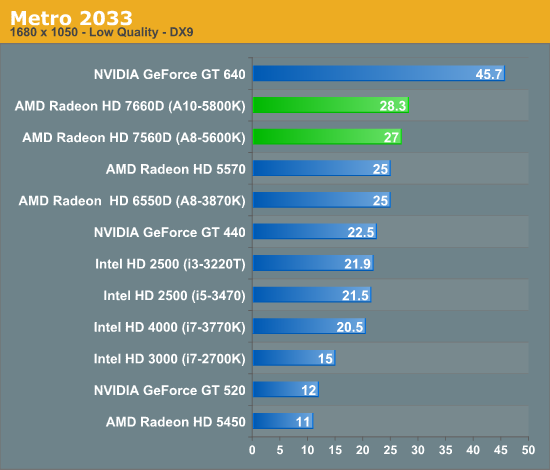AMD A10-5800K & A8-5600K Review: Trinity on the Desktop, Part 1
by Anand Lal Shimpi on September 27, 2012 12:00 AM ESTCrysis: Warhead
Our first graphics test is Crysis: Warhead, which in spite of its relatively high system requirements is the oldest game in our test suite. Crysis was the first game to really make use of DX10, and set a very high bar for modern games that still hasn't been completely cleared. And while its age means it's not heavily played these days, it's a great reference for how far GPU performance has come since 2008. For an iGPU to even run Crysis at a playable framerate is a significant accomplishment, and even more so if it can do so at better than performance (low) quality settings.



Crysis sets the tone for a lot of what we'll see in this performance review. The Radeon HD 7660D on AMD's A10-5800K boosts performance by around 15 - 26% over the top end Llano part. The smaller, Radeon HD 7560D GPU manages a small increase over the top-end Llano at worst, and at best pulls ahead by 18%.
Compared to Ivy Bridge, well, there's no comparison. Trinity is significantly faster than Intel's HD 4000, and compared to HD 2500 the advantage is tremendous.
Metro 2033
Our next graphics test is Metro 2033, another graphically challenging game. Like Crysis this is a game that is traditionally unplayable on many integrated GPUs, even in DX9 mode.



Metro 2033 shows us a 6 - 13% performance advantage for the top end Trinity part compared to Llano. The advantage over Intel's HD 4000 ranges from 20 - 40% depending on the resolution/quality settings. In general AMD is able to either deliver the same performance at much better quality or better performance at the same quality as Ivy Bridge.
The more important comparison is looking at the A8-5600K vs. Intel's HD 4000 and 2500. AMD is still able to hold onto a significant advantage there, even with its core-reduced GPU.










139 Comments
View All Comments
Kougar - Friday, September 28, 2012 - link
Given no mention of a "preview" was mentioned in the title, it would have been nice if the The Terms of Engagement section was at the very top of the "review" to be completely forthright with your readership.I read down to that section and stopped, then went looking through the review for CPU benchmarks which didn't exist. Can thank The Tech Report for posting an editorial on AMD's "preview" clause before I realized what was going on.
Omkar Narkar - Friday, September 28, 2012 - link
would you guys review 5880k crossfired with HD 6670 ???because I've heard that when you pair it with high end GPU like HD7870 then integrated graphics cores doesn't work.
TheJian - Friday, September 28, 2012 - link
Why was this benchmark used in the two reviews before the 660TI launch, and here today, but not in the 660TI article Ryan Smith wrote? This is just more stuff showing bias. He could have easily ran it with the same patch as the two reviews before the 660TI launch article. Is is because in both of those two articles the 600 series dominated the 7970ghz edition and the 7950 Boost? This is at the very least, hard to explain.plonk420 - Monday, October 1, 2012 - link
are those discrete GPUs on the charts being run on the AMD board? or a Sandy/Ivy?seniordady - Monday, October 1, 2012 - link
Please,can you make some test to the CPU vs... not only to the GPU?ericore - Monday, October 1, 2012 - link
http://news.softpedia.com/news/GlobalFoundries-28n...Power leaking reduced by up to 550%; wow.
What an unintended coup for AMD haha all because of Global Foundries.
Take that Intel.
AMD is also first one working on Java GPU acceleration.
shin0bi272 - Tuesday, October 2, 2012 - link
This is cool if you want to game at 13x7 at low res... but who does that anymore? When you bump up games like BF3 or Crysis2 (which you didnt test but toms did) the FPS falls into the single digits. This cpus is fine if you dont really play video games or have a 17" CRT monitor. The thing that I think is funny about this is that in all the games a 100 dollar nvidia gpu beat the living snot out of this apu. Other than HTPC people who want video output without having to buy a video card or someone who doesnt play FPS games but wants to play farmville or minecraft no one will buy this thing. Yet people are still trying to make this thing out to be a gaming cpu/gpu combo and its just not going to satisfy anyone who buys it to play games on and thats disingenuous.Shadowmaster625 - Tuesday, October 2, 2012 - link
When you tested your GT440, you didnt do it on this hardware right? If you were to disable the trinity gpu and put a GT640 in its place, do you think it would still do better? Or would its score be pretty close to that of the iGPU??skgiven - Sunday, October 7, 2012 - link
No idea what the NVidia GT440 is doing there; where are the old AMD alternatives?Given the all to limited review I don't see the point in comparing this to NVidia's discrete GT640.
Firstly, it's not clear if you are comparing the APU's to a DDR3 GT640 version (of which there are two; April 797MHz and June 900MHz) or the GDDR5 version (all 65W TDP).
Secondly, the GT640 has largely been superseded by the GTX650 (64W TDP).
So was your comparison the 612GFlops model, the 691, or 729 GFlops version?
Anyway, the GTX650 is basically the same card but has is rated as 812GFlops (30% faster than the April DDR3 model). Who knows, maybe you intended to add these details along with the GTX650Ti, in a couple of days?
If you are going to compare these APU to discrete entry level cards, you need to add a few more cards. Clearly the A10-5800k falls short against Intels more recent processors for most things (nothing new there), but totally destroys anything Intel has when it comes to gaming, so there is no point in over-analysing that. It wins that battle hands down, so the real question is, how does it perform compared to other gaming APU's and discrete entry level cards?
I'm not sure why you stuck to the same 1366 screen resolution? Can this card not operate at other frequencies, or can the opposition not compete at higher resolutions?
1366 is common for laptops. I don't think these 100W chips are really intended for that market. They are for small desktops, home theatre, entry level (inexpensive) gaming systems.
These look good for basic gaming systems and in terms of performance per $ and Watt, even for some office systems, but their niche is very limited. If you want a good home theatre/desktop/gaming system, throw in a proper discrete GPU and operate at a more sensible 1680 or 1920 for real HD quality.